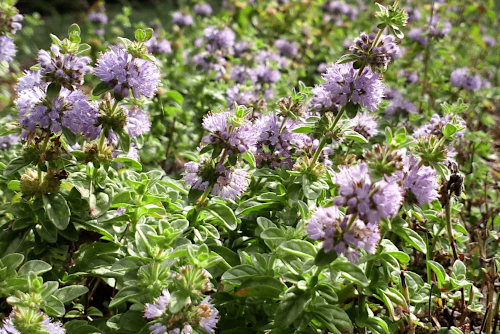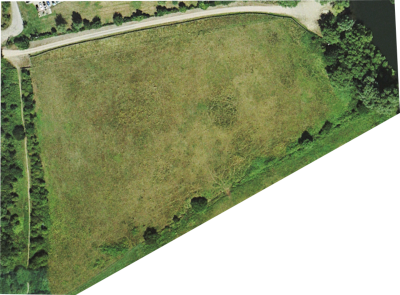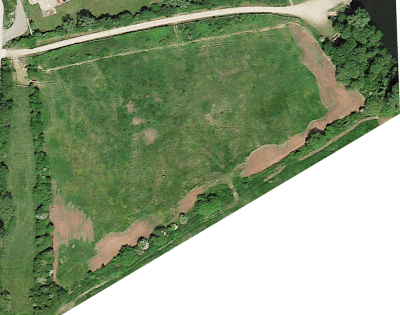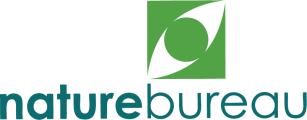RARE PLANT PROTECTION
Recovery of pennyroyal at Bray Field SSSI, 2011-2024

The Bray Pennyroyal Field SSSI comprises a single field of 3.4 ha owned by Eton College. It lies beside the River Thames to the south-east of Bray and represents the most important British locality for the nationally rare pennyroyal Mentha pulegium, a species included in Schedule 8 under the Wildlife and Countryside Act 1981 and listed in the British Red Data Book of vascular plants.
Pennyroyal is a creeping perennial of pond or lake margins and damp depressions and was formerly a locally common plant in most counties in England and Wales. However, over the last 50 years it has suffered a severe decline largely as a result of the cessation of grazing over many lowland commons, and the consequent overgrowth by tall vegetation and scrub. Today, pennyroyal distribution is limited to just a handful of sites including Bray, some in Cornwall, the New Forest and a single site in Wales.
Bray Field is shown as a grazed floodplain meadow on 19th Century maps but today it overlies an in-filled gravel pit excavated in the 1960s. The topography comprises a mainly flat field characterised by a series of shallow, seasonally inundated depressions to which the pennyroyal colonies are confined. The Bray site population was discovered in 1967 and a photograph from 1986 indicates that in the mid-1980s the plant grew abundantly across the site, which was clearly used as a pasture for horse and cattle grazing.
In March 2003, English Nature (now Natural England) stated that active management of the wet grassland at Bray SSSI was needed to maintain the conservation interest. In particular, pennyroyal requires hard grazing and light trampling, best achieved by the use of ponies or horses. However, a site visit by Natural England in 2010, evaluated Bray as being in unfavourable condition due to undergrazing. The pennyroyal population had declined in recent years and the field had not been grazed in some time – sward height was well above the 5-15 cm target and scrub was increasing.
Implementing conservation measures
In autumn 2011, NatureBureau was contracted by Eton College to take over management activities relating to the Bray site. We carried out preliminary baseline vegetation surveys in spring 2012, concluding that the site was largely comprised of semi-improved neutral grassland surrounded by unmanaged hedges of mixed broadleaf tree and scrub species, and that pennyroyal was widely but sparsely distributed around the site. A recovery strategy for pennyroyal was developed based on a number of measures: the reintroduction of traditional mixed stock grazing (initially cattle), removal of ragwort that had spread across the site (to allow horse grazing), and clearance of encroaching scrub to increase the grassland area and reduce shading of pennyroyal. A contract to implement these measures was concluded with Eton College, including the administration of an Environmental Stewardship agreement between Eton College and Natural England that began in July 2012.
 |  |  400px.jpg) | |
Bray Field 2003 showing scrub encroachment (Google Earth) | Bray Field 2013 after scrub removal (Google Earth) | Scrub clearance at Bray Field (Paul Goriup) | Dexter cattle at Bray Field (Stephen Beale) |
To implement the strategy, works were carried out between 2012 and 2017 to erect livestock fencing, a corral, new gates, water supply (pipe and trough), and undertake scrub control and management. During these works, in 2013 and 2014, it was observed that pennyroyal readily colonised the newly exposed earth forming linear patches, despite them being deliberated situated far away from existing patches. By autumn 2013, it was found that pennyroyal populations had greatly expanded out of the low wet areas and were mostly associated with the ruts and disturbance caused by the site improvement works.
With consent from Natural England, a trial of deliberate creation of ruts was carried out on 31 March 2014. A tractor was driven across some small wet areas where pennyroyal had not been recorded during the previous surveys. By September 2014, pennyroyal was observed growing within the ruts across all three disturbed areas and by the end of the year were the most successful new populations of pennyroyal found. The original populations of pennyroyal had apparently ensured a viable seed bank, and the mechanical disturbance had promoted their germination.
In December 2014, the site was ready for livestock and a grazing agreement was made with a grazier to field Dexter cattle at a stocking density of 1 Lu/
Ha. The intention was that the cattle would control scrub encroachment, keep grass height low and poach the soil to create wet depressions. Unfortunately,
the poor quality of the grassland meant that the livestock could only graze for relatively short periods of time, and while some poaching was achieved, scrub encroachment accompanied by drying out and loss of bare ground gradually caused the initial flush of pennyroyal regrowth to decline. By September 2018, the population and extent of pennyroyal had declined significantly across much of the site, while brambles were invading formerly important areas. Significant rainfall in 2019 and 2020 elicited a partial recovery of the population in depressions which had not been wet previously (winter surveys during frosts when such depressions iced over allowed us to map microtopography more easily). Nevertheless, a site inspection by Natural England in 2021 noted that the continued presence of large quantities of ragwort and scrub still kept the site in unfavourable status.
Consequently, from 2021 to 2023, with further funding from Environmental Stewardship, a more intensive campaign of scrub clearance (with the biomass mulched and removed), ragwort pulling with the help of local volunteers, and further mechanical soil disturbance was implemented (the earlier ruts having largely filled in). Cattle were also grazed in larger number more frequently. As a result, pennyroyal quickly recovered and by late 2023 had spread to its most extensive extent since 1986, even reappearing on areas formerly covered with scrub, and Natural England accorded favourable status to the SSSI after a visit in spring 2024.
